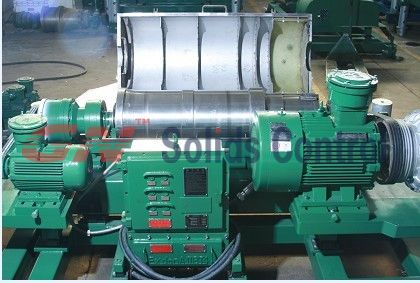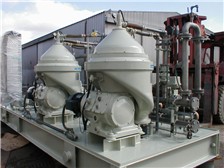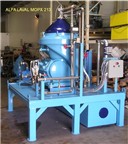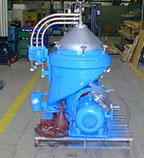Only 0.7 percent of the weight of natural uranium, the U-235 isotope found in nature’s uranium, is the isotope needed to power a nuclear reactor. The U-235 isotope is the one that splits inside the core. It is this isotope which releases energy in the fission process. Because natural uranium can not power a nuclear reactor, the concentration of U-235 must be slightly increased, also known as ‘low enrichment,’ from 0.7 percent to between 3 and 5 percent. The enrichment occurs during the centrifuge process.
Because natural uranium can not power a nuclear reactor, the concentration of U-235 must be slightly increased, also known as ‘low enrichment,’ from 0.7 percent to between 3 and 5 percent. The enrichment occurs during the centrifuge process.
It is called the ‘gas centrifuge process” because gaseous uranium hexafluoride (UF6) is fed into a cylindrical, high-speed rotor. The gas is whirled around inside thousands of centrifuges in a nearly friction-free environment, separating the fissionable U-235 isotope from the heavier U-238 isotope.  The centrifugal motion pushes the heavier U-238 gas away from the useful U-235 gas, which remains closer to the rotor axis. The process is repeated until the desired enrichment percentage is achieved.
The centrifugal motion pushes the heavier U-238 gas away from the useful U-235 gas, which remains closer to the rotor axis. The process is repeated until the desired enrichment percentage is achieved.
Let’s back up the process a few steps. First, uranium is mined and milled. The finished product, which is shipped off to the conversion facility, is called yellowcake.
The next step in creating nuclear fuel for a reactor is the conversion process. The yellowcake, or U3O8, is converted into uranium hexafluoride, or UF6. Yellowcake is dissolved in nitric acid to create a new solution, uranyl nitrate. Hydrogen is then used to reduce this to UO2. This is then converted to UF4 with hydrofluoric acid. The UF6 is obtained with the uranium is oxidized with fluorine. At ambient temperatures, UF6 forms solid grey crystals. Depending upon its temperature, uranium hexafluoride can be a solid, liquid or gas.
This is then converted to UF4 with hydrofluoric acid. The UF6 is obtained with the uranium is oxidized with fluorine. At ambient temperatures, UF6 forms solid grey crystals. Depending upon its temperature, uranium hexafluoride can be a solid, liquid or gas.
After the U3O8 has been converted to UF6, it is transported to the enrichment site in an internationally standard transport container. The solid UF6 is heated up in an air-tight pressure vessel until it returns to its gaseous state. It is then fed into the centrifuge. The Urenco ‘gas centrifuge’ has two pipes, one which removes the enriched uranium and another which removes the heavier uranium, depleted of U-235.

Because a single centrifuge won’t enrich the uranium to the desired level, a number of centrifuges are connected together. The connected, parallel centrifuges are called a cascade. By passing through each of the centrifuges in the cascade, the U-235 is gradually enriched to the level required by the customer, a nuclear power plant.
After the desired enrichment level is achieved, the enriched UF6 gas is passed through a series of compressors and packaged into product containers. The UF6 gas is cooled until the vapors solidify onto the walls of the container. The finished product is shipped to the fuel fabrication plant where the solid, enriched uranium is manufactured into fuel pellets.
The key to expansion, after sufficient U3O8 has been mined, is ensuring the uranium is converted and enriched so that it can fuel nuclear power plants. Until now, U.S. utilities have relied upon Russian HEU to LEU supplies to fuel their nuclear reactors. Urenco’s NEF in New Mexico gives a boost to the nuclear energy sector, and provides U.S. utilities with an alternative to having uranium enriched at USEC’s Kentucky plant, or worse yet, shipping domestically produced uranium overseas for enrichment. For instance, Brazil was forced to have its uranium enriched in Europe, until recently.
Value-adding to the fuel supplying reactors can mean big money for LES, and especially for Urenco Ltd. But, the investment of $1.5 billion will also produce hundreds of new jobs for the border towns of both New Mexico and Texas. Estimates show about 800 construction jobs will be created as the facility is being built, and as many as 1200 during the peak of the construction. About 300 employees will be required to operate the facility. Nearby Andrews, Texas has been celebrating the National Enrichment Facility. The city manager expects the number of new homes under construction to jump by 10-fold this year. School enrollment has grown over the past year while newcomers have moved into the area, hoping for construction jobs.
Urenco’s National Enrichment Facility should begin construction later this summer, probably in August. Louisiana Energy Services (LES) hopes to start selling enriched uranium in 2009, probably to its U.S. utility partners, who hope to build new reactors.
A statement issued by the Nuclear Energy Institute (NEI) on Friday, congratulating LES for the approval of its NRC license pointed ahead to the U.S. expansion of the nuclear energy sector. The NEI’s chief nuclear officer, Marvin Fertel, said, “This experience bodes well for the construction and operating license applications for new nuclear power plants that are expected to be submitted to the agency beginning in 2007.”
 Because natural uranium can not power a nuclear reactor, the concentration of U-235 must be slightly increased, also known as ‘low enrichment,’ from 0.7 percent to between 3 and 5 percent. The enrichment occurs during the centrifuge process.
Because natural uranium can not power a nuclear reactor, the concentration of U-235 must be slightly increased, also known as ‘low enrichment,’ from 0.7 percent to between 3 and 5 percent. The enrichment occurs during the centrifuge process.It is called the ‘gas centrifuge process” because gaseous uranium hexafluoride (UF6) is fed into a cylindrical, high-speed rotor. The gas is whirled around inside thousands of centrifuges in a nearly friction-free environment, separating the fissionable U-235 isotope from the heavier U-238 isotope.
 The centrifugal motion pushes the heavier U-238 gas away from the useful U-235 gas, which remains closer to the rotor axis. The process is repeated until the desired enrichment percentage is achieved.
The centrifugal motion pushes the heavier U-238 gas away from the useful U-235 gas, which remains closer to the rotor axis. The process is repeated until the desired enrichment percentage is achieved.Let’s back up the process a few steps. First, uranium is mined and milled. The finished product, which is shipped off to the conversion facility, is called yellowcake.
The next step in creating nuclear fuel for a reactor is the conversion process. The yellowcake, or U3O8, is converted into uranium hexafluoride, or UF6. Yellowcake is dissolved in nitric acid to create a new solution, uranyl nitrate. Hydrogen is then used to reduce this to UO2.
 This is then converted to UF4 with hydrofluoric acid. The UF6 is obtained with the uranium is oxidized with fluorine. At ambient temperatures, UF6 forms solid grey crystals. Depending upon its temperature, uranium hexafluoride can be a solid, liquid or gas.
This is then converted to UF4 with hydrofluoric acid. The UF6 is obtained with the uranium is oxidized with fluorine. At ambient temperatures, UF6 forms solid grey crystals. Depending upon its temperature, uranium hexafluoride can be a solid, liquid or gas.After the U3O8 has been converted to UF6, it is transported to the enrichment site in an internationally standard transport container. The solid UF6 is heated up in an air-tight pressure vessel until it returns to its gaseous state. It is then fed into the centrifuge. The Urenco ‘gas centrifuge’ has two pipes, one which removes the enriched uranium and another which removes the heavier uranium, depleted of U-235.

Because a single centrifuge won’t enrich the uranium to the desired level, a number of centrifuges are connected together. The connected, parallel centrifuges are called a cascade. By passing through each of the centrifuges in the cascade, the U-235 is gradually enriched to the level required by the customer, a nuclear power plant.
After the desired enrichment level is achieved, the enriched UF6 gas is passed through a series of compressors and packaged into product containers. The UF6 gas is cooled until the vapors solidify onto the walls of the container. The finished product is shipped to the fuel fabrication plant where the solid, enriched uranium is manufactured into fuel pellets.
The key to expansion, after sufficient U3O8 has been mined, is ensuring the uranium is converted and enriched so that it can fuel nuclear power plants. Until now, U.S. utilities have relied upon Russian HEU to LEU supplies to fuel their nuclear reactors. Urenco’s NEF in New Mexico gives a boost to the nuclear energy sector, and provides U.S. utilities with an alternative to having uranium enriched at USEC’s Kentucky plant, or worse yet, shipping domestically produced uranium overseas for enrichment. For instance, Brazil was forced to have its uranium enriched in Europe, until recently.

Value-adding to the fuel supplying reactors can mean big money for LES, and especially for Urenco Ltd. But, the investment of $1.5 billion will also produce hundreds of new jobs for the border towns of both New Mexico and Texas. Estimates show about 800 construction jobs will be created as the facility is being built, and as many as 1200 during the peak of the construction. About 300 employees will be required to operate the facility. Nearby Andrews, Texas has been celebrating the National Enrichment Facility. The city manager expects the number of new homes under construction to jump by 10-fold this year. School enrollment has grown over the past year while newcomers have moved into the area, hoping for construction jobs.
Urenco’s National Enrichment Facility should begin construction later this summer, probably in August. Louisiana Energy Services (LES) hopes to start selling enriched uranium in 2009, probably to its U.S. utility partners, who hope to build new reactors.

A statement issued by the Nuclear Energy Institute (NEI) on Friday, congratulating LES for the approval of its NRC license pointed ahead to the U.S. expansion of the nuclear energy sector. The NEI’s chief nuclear officer, Marvin Fertel, said, “This experience bodes well for the construction and operating license applications for new nuclear power plants that are expected to be submitted to the agency beginning in 2007.”












